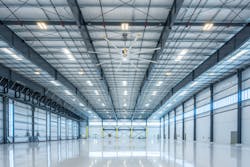Understanding Aircraft Hangar Fire Suppression Standards
Airport hangars have traditionally required a higher level of fire detection and suppression due to their size and use. However, modern hangars and aircraft are now equipped with technologies providing more effective protection from potential ignition sources than ever before. A rapid response must not only consider advances in technology, but the protection of life and property in the event of false alarms.
There is no debate that aircraft hangars pose unique challenges for fire protection. First, they are three-sided structures with large open doors and high ceilings that present a unique environment to control smoke and fire. They also house aircraft containing liquid jet fuel with a low flashpoint and maintenance activities that may provide potential ignition sources. These aircraft and their support equipment may create obstructions to both fire detection and suppression in the large hangar space.
With that said, hangar fires are very rare and the risk to personnel and aircraft is low, but the focus of fire suppression has traditionally rested on the structure. The National Fire Protection Agency (NFPA) sets a stringent standard for fire suppression and building codes in aircraft hangars in NFPA 409. Widely accepted as the industry standard, NFPA 409 helps safeguard life and property through requirements for the proper construction and fire protection of aircraft hangars used for aircraft storage, maintenance or related activities.
It is important to distinguish the NFPA provides only guidance and does not have rulemaking authority on its own. The codes found in the International Business Code (IBC) are the standards that prevail, and which are adhered to by local permitting agencies. This is a source of conflict because NFPA standards become primary requirements when adopted by a local jurisdiction – typically a fire agency relied upon by building departments for internal review and approval of hangar construction projects.
Currently, there are more than 300 codes and standards in place, with interpretations varying at the local level by authorities who exercise considerable discretion. NFPA 409 lists various fire protection options for aircraft hangars based on four classifications:
· Group I - The hangar must have either an aircraft access door over 28 feet in height, a single fire area greater than 40,000 square feet, or be able to house an aircraft with a tail height of over 28 feet.
· Group II - The hangar must have an aircraft access door height of 28 feet or less, and a single fire area less than 40,000 square feet based on construction type (as listed in Table 4.1.2 of NFPA 409).
· Group III - The hangar must have an access door height of 28 feet or less and a single fire area less than 30,000 square feet (as listed in Table 4.1.3 of NFPA 409).
· Group IV – The hangar is any membrane-covered, rigid-steel frame structure used for the storage or servicing of aircraft.
Once you’ve determined the classification of your aircraft hangar, you can determine the specific fire protection requirements it needs to meet. Group IV aircraft hangars are generally subject to the least stringent requirements, while Group I aircraft hangars are held to the strictest requirements.
In 2021, the NFPA approved some modifications to NFPA 409 that were released in its 2022 edition. Prior to publication, the NFPA attempted to impose a new standard requiring the installation of foam fire suppression systems in Group II hangars. However, the National Air Transportation Association (NATA) lobbied against this charge with the support of airport users and operators, fire protection experts and aviation insurance providers.
The NATA successfully argued that the risks of seemingly-arbitrary foam fire suppression requirements in Group II aircraft hangars outweighed the rewards – in terms of negative economic impacts and the numerous hazards associated with inadvertent foam discharge.
For example, some firefighting foams have links to per- and polyfluoroalkyl substances (PFAS) that could increase the risk of cancer and other adverse health effects. PFAS are a class of chemicals that do not naturally break down and accumulate in water, soil and the human body.
In addition, aviation insurance industry data shows it is more likely for an inadvertent foam discharge to damage property, interrupt businesses and take aircraft out of service than a hangar fire. In the rare occurrence of a hangar fire, its origin is not typically aircraft fuel and it tends to occur in less sophisticated environments.
This data supports the conclusion that it is difficult, if not impossible, to reconcile fire loss history with the implementation of more stringent fire code requirements for Group II aircraft hangars. It is even more critical to consider that when foam is inadvertently discharged, persons occupying the aircraft hangar have very little time to evacuate and can be instantly overcome by the volume of foam both ascending from the floor and descending from the ceiling.
Following numerous risk-analysis studies, the NFPA determined Group II aircraft hangars do not require firefighting foam systems and removed the proposed requirement. This means airport businesses can use their own discretion to determine the best fire suppression system, such as a water-based sprinkler and drain system. However, the local authority with jurisdiction must still approve the chosen method.
In addition to the exemption of Group II aircraft hangars from foam requirements, NFPA 409 includes a few other important changes. These include provisions to create an alternative performance-based design process and allow modification for any part of NFPA 409; a provision to create a risk-assessment process that allows users to propose alternative fire protection methods, with or without foam; and approval of the use of ignitable liquid floor drainage systems.
To improve safety, the fire protection industry is shifting to fluorine-free foam concentrates, but this may prove cost-prohibitive for many tenant businesses. On the positive side, changes to NFPA 409 may provide opportunities for more effective solutions when proven applicable and safe. While the historical trend by NFPA has been to advocate foam systems, a thorough risk assessment may prove the best option is to permit water-only fire protection.
NATA has released an educational guide for hangar owners and operators seeking a general understanding of updated hangar foam suppression system requirements, options and alternatives. It includes information on hangar classification, code exceptions, how to determine if foam protection systems are required and recommendations on foam systems.
Available free online, NATA’s Aircraft Hangar Fire Protection Guidance also features a flow chart on various options to achieve code compliance relative to fire suppression systems based on the International Building Code, 2021 edition; International Fire Code, 2021 edition; and 2016 edition of NFPA 409.
Moving forward, it remains critically important for the NFPA and local authorities to understand and accommodate the unique operating environment of general aviation businesses. It’s encouraging that NFPA technical committees are finally recognizing the environmental risks associated with foam fire suppression systems in regard to accidental discharge far outweigh the benefits.
About the Author

Curt Castagna
President and CEO
Curt Castagna, President/CEO of Ascension Group Partners, serves as president and CEO of the National Air Transportation Association, member and past chair of the Los Angeles County Airport Commission, and president of the Van Nuys and Long Beach airport associations. A certified private, seaplane and instrument-rated pilot, he continues to instruct courses in aviation administration at Cypress Community College and Cal State Los Angeles.
